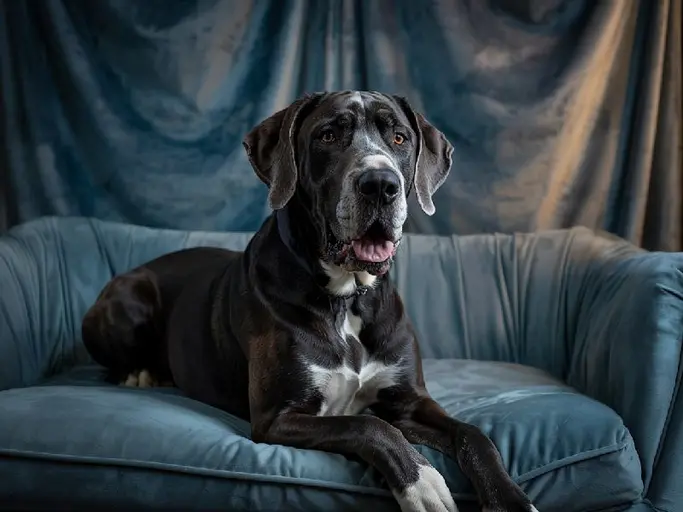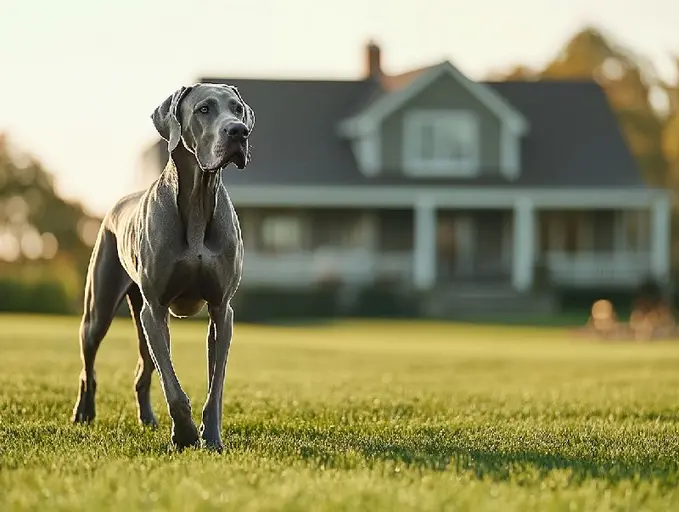The Great Dane: A Comprehensive Guide to this Gentle Giant

Brief Introduction
The Great Dane, often called the “Apollo of Dogs,” is a truly majestic and impressive breed. Known for its towering height and graceful build, the Great Dane combines immense size with elegance and power. Despite their imposing stature, Great Danes are typically gentle giants, known for their sweet and affectionate nature. Their distinctive appearance, combined with their relatively calm temperament, makes them a popular choice for families and individuals alike. The breed’s unique appeal lies in their paradoxical nature: a dog of enormous size that is, at heart, a loving and loyal companion.
Breed History
The Great Dane’s history is rich and somewhat complex, tracing back centuries. While the name might suggest Danish origins, the breed actually developed primarily in Germany.
Origins and Development
The ancestors of the Great Dane were likely boarhounds, large and powerful dogs used for hunting wild boar. These early boarhounds were a diverse group, with varying sizes and appearances. Over time, breeders in Germany began to refine these dogs, selecting for specific traits such as size, strength, and hunting ability.
Evolution and Refinement
The Great Dane wasn’t originally a specific breed, but rather a type of dog used for a particular purpose. These dogs were used to hunt large game and guard estates. As hunting styles changed and firearms became more prevalent, the need for boarhounds diminished. However, breeders continued to refine the Great Dane, transforming it from a working dog into more of a companion animal. This involved selecting for a more gentle temperament and a more refined appearance. The breed evolved through crosses with English Mastiffs and Irish Wolfhounds, contributing to their great size and imposing presence.
Formal Recognition
The breed was formally recognized in Germany in the late 19th century, where it was known as the “Deutsche Dogge” (German Mastiff). The name “Great Dane” became popular in English-speaking countries, although the exact origins of this name are somewhat unclear. The American Kennel Club (AKC) officially recognized the Great Dane in 1887.
Appearance
Great Danes are easily recognizable due to their incredible size and elegant build. They are one of the tallest dog breeds, possessing a commanding presence that is hard to ignore.
Size and Weight
- Height: Males typically stand at least 30 inches (76 cm) tall at the shoulder, while females are usually around 28 inches (71 cm) or taller. Some individuals can even exceed these heights.
- Weight: Males generally weigh between 140 and 175 pounds (63-79 kg), while females typically weigh between 110 and 140 pounds (50-63 kg).
Coat and Color
Great Danes have a short, dense coat that is smooth and glossy. They come in several recognized colors and patterns:
- Fawn: A golden-yellow color with a black mask.
- Brindle: Fawn with black stripes.
- Blue: A steel-gray color.
- Black: A solid black color.
- Harlequin: A white base coat with irregular black patches distributed over the body.
- Mantle: A black blanket extending over the body, with a white muzzle, chest, and sometimes white legs.
- Merle: An acceptable variation with a marbling effect
Head and Facial Features
Their head is long and rectangular with a well-defined stop (the indentation between the forehead and muzzle). The muzzle is broad and strong.
- Eyes: The eyes are medium-sized, dark, and almond-shaped, conveying intelligence and kindness.
- Ears: The ears are naturally drop ears, set high on the head. Many breeders and owners choose to crop the ears, though this practice is becoming less common and is banned in some countries. Cropped ears stand erect.
Tail
The tail is thick at the base and tapers to a point. It reaches to the hock (ankle) and is carried level with the back or slightly curved.
Character and Behavior
Despite their size, Great Danes are known for their gentle and affectionate nature. They are often described as “gentle giants” due to their loving disposition.
Temperament and Personality
Great Danes are generally good-natured and friendly dogs. They are known to be patient and tolerant, making them good family pets. They are also intelligent and eager to please, although they can sometimes be a bit stubborn.
Attitude Towards People and Children
Great Danes typically form strong bonds with their families and are affectionate towards children. They are generally gentle and patient with kids, but supervision is always recommended, especially with very young children, due to the dog’s large size. Early socialization is crucial to ensure they are comfortable around strangers and in various social situations.
Interaction with Other Animals
With proper socialization from a young age, Great Danes can coexist peacefully with other dogs and even cats. However, their size and prey drive can sometimes be a factor, so careful introductions are necessary, particularly with smaller animals.
Activity Level and Exercise Needs
While Great Danes are not overly hyperactive, they do require regular exercise to stay healthy and happy. A daily walk or two is usually sufficient, but they also enjoy playing in a fenced yard or going for hikes. It’s important to avoid excessive exercise during puppyhood to protect their developing joints.
Trainability
Great Danes are intelligent dogs and can be trained with patience and consistency. Positive reinforcement methods, such as treats and praise, work best. Early socialization and obedience training are essential to ensure they develop into well-behaved and well-adjusted adults. Early training is crucial, especially regarding leash manners, due to their size and potential pulling power.

Care and Maintenance
Caring for a Great Dane requires understanding their specific needs, especially considering their large size and potential health concerns.
Grooming Requirements
Great Danes have a short, smooth coat that is relatively easy to groom. Regular brushing with a rubber brush or grooming mitt will help remove loose hair and keep their coat healthy and shiny. They don’t require frequent bathing, but when needed, use a gentle dog shampoo.
Exercise Needs
As mentioned earlier, Great Danes require regular exercise to stay healthy. A daily walk or two, combined with some play time, is usually sufficient. Avoid strenuous exercise during puppyhood to prevent joint problems.
Feeding Requirements
Feeding a Great Dane can be expensive, as they require a significant amount of food. It’s crucial to feed them a high-quality dog food specifically formulated for large breeds. This will help ensure they get the necessary nutrients without growing too quickly, which can contribute to joint problems. Monitor their weight and adjust their food intake as needed to prevent obesity.
Health Considerations
Great Danes are prone to certain health problems, including:
- Bloat (Gastric Dilatation-Volvulus): A life-threatening condition where the stomach fills with gas and twists. Preventive measures include feeding smaller meals throughout the day and avoiding exercise immediately before or after eating.
- Hip Dysplasia: A malformation of the hip joint that can lead to arthritis and pain. Responsible breeders screen their dogs for hip dysplasia before breeding.
- Cardiomyopathy: A disease of the heart muscle that can lead to heart failure. Regular veterinary checkups and screening can help detect this condition early.
- Bone Cancer (Osteosarcoma): Great Danes are at a higher risk for developing bone cancer than some other breeds.
- Wobbler Syndrome (Cervical Spondylomyelopathy): A neurological condition that affects the spinal cord in the neck, causing weakness and incoordination.
Average Lifespan
Unfortunately, Great Danes have a relatively short lifespan compared to some other breeds. Their average lifespan is typically 7 to 10 years.
Breed Weaknesses
While Great Danes are generally wonderful dogs, they do have some potential weaknesses to consider:
Potential for Aggression (Rare)
Although generally gentle, some Great Danes can exhibit aggression if not properly socialized and trained. This is more likely to occur in dogs that are fearful or insecure.
Loyalty and Dependence
Great Danes are very loyal and affectionate dogs, which can sometimes lead to separation anxiety if they are left alone for long periods.
Specific Weaknesses
- Health Problems: As mentioned earlier, Great Danes are prone to certain health problems, which can be costly to treat.
- Short Lifespan: Their relatively short lifespan can be heartbreaking for owners.
- Space Requirements: Due to their large size, Great Danes require a significant amount of space and are not well-suited for small apartments.
- Drooling: Some Great Danes are prone to drooling, particularly after eating or drinking.
Conclusion
The Great Dane is a magnificent breed that can make a wonderful companion for the right owner. They are gentle, affectionate, and relatively easy to groom. However, they also require a significant commitment in terms of space, food, exercise, and healthcare. This breed is best suited for individuals or families who have the time, resources, and experience to properly care for a large dog with specific needs. If you are prepared to meet these challenges, you will be rewarded with the unconditional love and companionship of a truly remarkable breed. Careful consideration is essential before bringing a Great Dane into your home.
Frequently Asked Questions About Great Dane
-
What is the Great Dane breed known for?
The Great Dane, often called the “Apollo of Dogs,” is known for its towering height, graceful build, and gentle giant temperament. Despite their immense size, they are typically sweet and affectionate.
-
Where did the Great Dane breed originate?
While the name might suggest Danish origins, the Great Dane actually developed primarily in Germany. Their ancestors were boarhounds, used for hunting wild boar.
-
How big do Great Danes get?
Males typically stand at least 30 inches (76 cm) tall, and weigh between 140 and 175 pounds (63-79 kg). Females are usually around 28 inches (71 cm) or taller, and weigh between 110 and 140 pounds (50-63 kg).
-
What colors do Great Danes come in?
Great Danes come in several recognized colors and patterns, including Fawn, Brindle, Blue, Black, Harlequin, Mantle, and Merle.
-
Are Great Danes good with children?
Great Danes typically form strong bonds with their families and are affectionate towards children. They are generally gentle and patient, but supervision is always recommended, especially with very young children, due to the dog’s large size.
-
How much exercise do Great Danes need?
While Great Danes are not overly hyperactive, they do require regular exercise to stay healthy and happy. A daily walk or two is usually sufficient, but they also enjoy playing in a fenced yard or going for hikes.
-
What are some common health problems in Great Danes?
Great Danes are prone to certain health problems, including Bloat (Gastric Dilatation-Volvulus), Hip Dysplasia, Cardiomyopathy, Bone Cancer (Osteosarcoma), and Wobbler Syndrome (Cervical Spondylomyelopathy).
-
How long do Great Danes typically live?
Unfortunately, Great Danes have a relatively short lifespan compared to some other breeds. Their average lifespan is typically 7 to 10 years.
-
Do Great Danes require a lot of grooming?
Great Danes have a short, smooth coat that is relatively easy to groom. Regular brushing with a rubber brush or grooming mitt will help remove loose hair and keep their coat healthy and shiny.
-
Are Great Danes good for apartment living?
Due to their large size, Great Danes require a significant amount of space and are not well-suited for small apartments. They thrive best in homes with a yard where they can move around comfortably.

